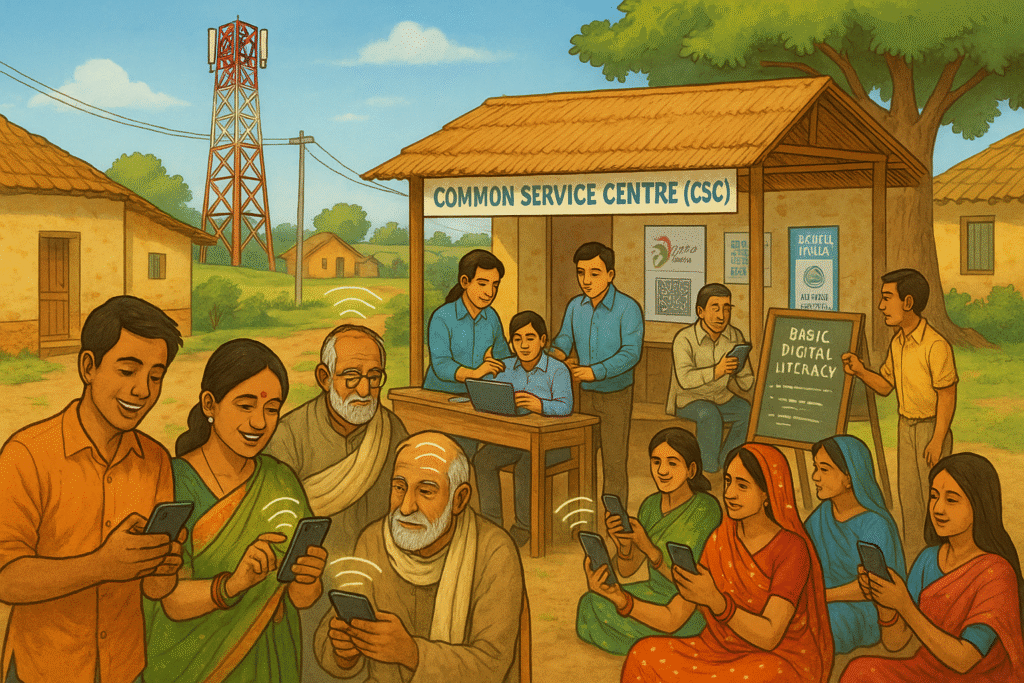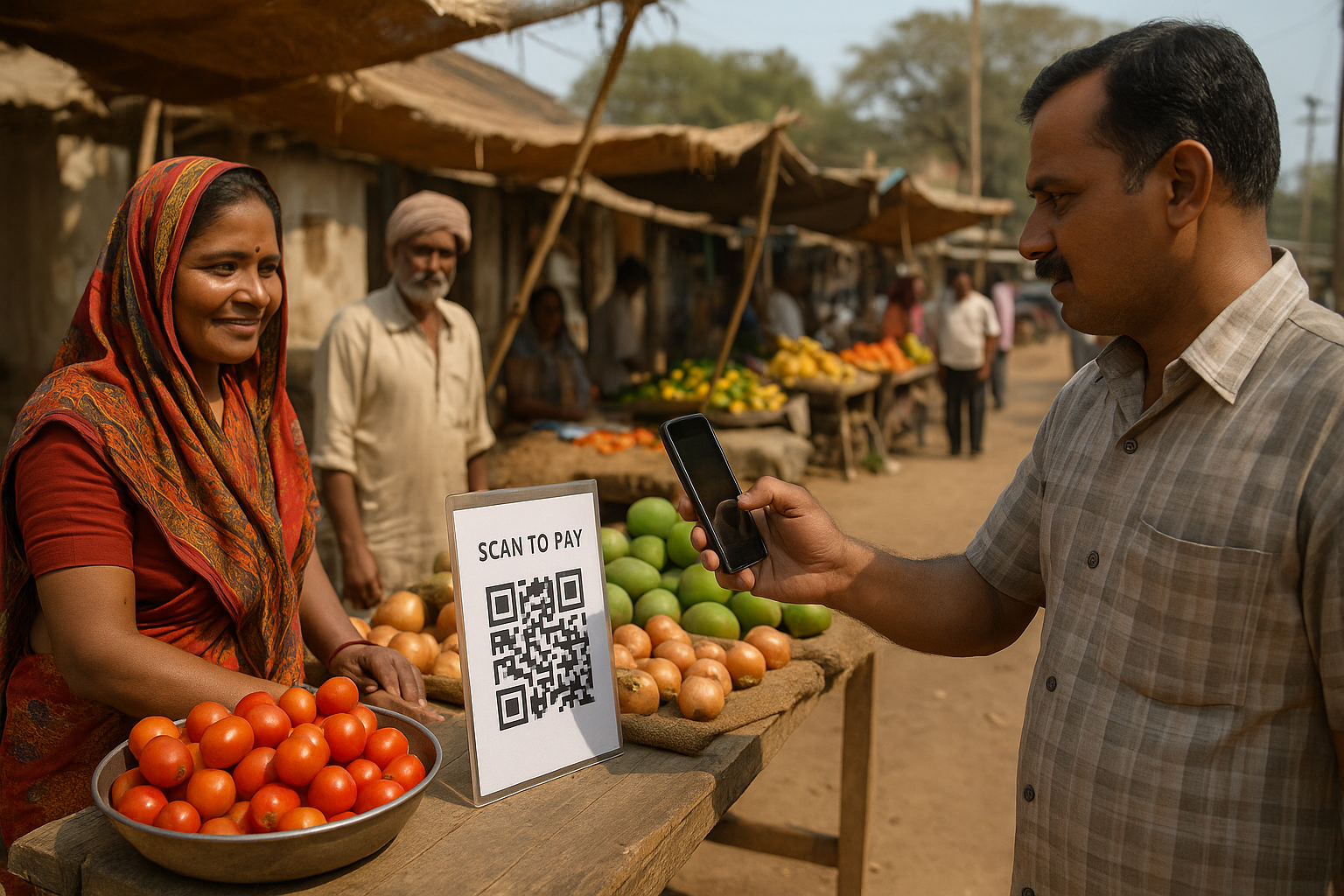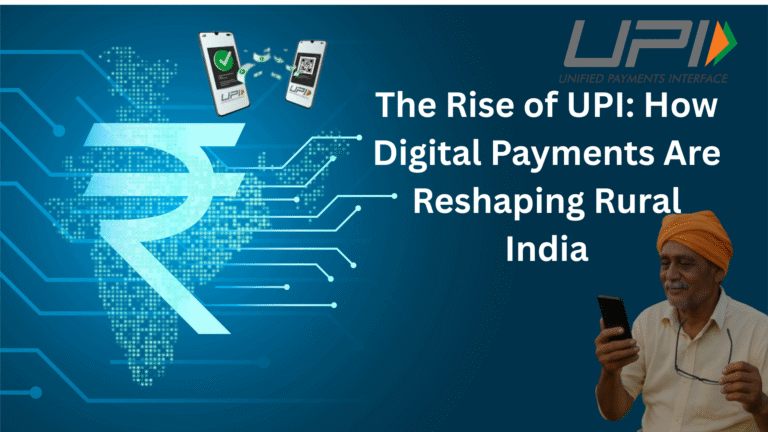A silent revolution is sweeping through India’s villages. It’s not carried out by protest or politics, but by led by technology, tiny taps on screens, QR codes at tea stalls, and instant payment notifications. This revolution is called UPI (Unified Payments Interface), and it’s transforming how rural India earns, spends, and saves.
Launched in 2016 by the National Payments Corporation of India (NPCI), Unified Payments Interface, which was once a city-centric technology, is now transforming the very fabric of rural India’s financial landscape, where smartphones have turned into digital wallets. This growth of UPI represents more than just a tech achievement; it’s a story of rural empowerment, inclusion, and economic opportunity.
What is UPI and Why It’s a Game-Changer
UPI is a real-time payment system, allowing the transfer of funds 24/7, bill payments, and shopping online, all through one mobile application irrespective of the bank used. Its simplify transactions by using UPI ID or Virtual Payment Address (VPA), making online transactions quickly and comfortably, while keeping bank details confidential.
Key Features:
- Instant transfers: transfers and payments are made instantly, any time of the day.
- Interoperable: it never matters whether the other person is using the same bank or app.
- No transaction fees (certainly for most users): this helps lift a hurdle for the low-income population.
- Easy to use: even new users, especially those who are not tech-savvy, find easy access to it.
UPI has greatly enhanced access to finance in rural India by eliminating the necessity of traveling to banks, standing in queues, and reducing dependence on cash. In areas with poor banking infrastructure, it removes geographic and bureaucratic constraints.
Breaking Barriers: Banking at the Last Mile
For decades, India’s villages often operated outside the formal banking system, hindered by the tyranny of distance and tangled paperwork. UPI has changed the paradigm. All it takes is a smartphone, an internet connection effective enough to go through UPI, and a bank account, with the latter often being supported by the government’s Jan Dhan Yojana. The intermediation of distance and reduction of procedural friction by UPI has brought the bank into the palm of every villager’s hand.
- Direct Transfers: The payments for wages, subsidies, or benefits are released instantly, with no intermediaries in between and thus no waiting.
- No More Cash Headaches: Farmers sell produce and get monetarily compensated instantly; local vendors are able to accept payments digitally.
- Easy Access: Even with basic phones and patchy internet, UPI works via QR codes, SMS options, and soon, voice-based UPI.
The Digital India Push: Policy Behind Progress
The expansion of UPI in rural India has not happened by accident. It’s the result of a strategic policy push:
- Through Jan Dhan Yojana over 500 million rural bank accounts were opened that set the basement for digital transactions.
- Digital India campaign focussed on expansion of internet connectivity, awareness generation, and building digital infrastructure, so that even the remotest villages can access online services.
- Aadhaar-Enabled Payment Systems (AEPS) use biometric authentication, critical in the case of users who either cannot read or are unfamiliar with technology; Direct Benefit Transfers (DBT) make sure government payments reach beneficiaries instantly and transparently.
- PMGDISHA (Pradhan Mantri Gramin Digital Saksharta Abhiyan) is about fast-tracking digital literacy, so even the novice on smartphone becomes a UPI user.
Further government’s effort to promote the BHIM app (a special UPI app for masses) and launched incentives (such as waiving merchant discount rates for low-value transactions) that encourage both users and low-value merchants in villages to adopt digital means. UPI services are delivered by banks, telecom operators, fintech start-ups, and government-run Common Service Centres (CSCs).
All these initiatives combinedly, have created a digital ecosystem that empowers even first-time smartphone users to transact digitally.
Infrastructure Growth in Rural India
UPI’s penetration in remote India can be attributed to a strong, steadily improving digital backbone:

- Smartphone & data boom: Affordable smartphones and data plans have made access to internet universal, even in those geographies that were once deemed unworthy of investment in infrastructure on account of costs.
- Mobile network expansion: Out of 2.5 lakh villages, almost 90 percent enjoy coverage by 4G networks. On 5G rollout, villagers can expect further enhancements.
- Local agents & CSCs: Rural agents, CSCs, and digital kiosks are facilitators that help villagers along the lines of awareness, onboarding, and transaction support.
This infrastructure has not only enabled access but also built trust which is critical in communities where digital tools were once viewed with suspicion.
How UPI is Reshaping the Rural Economy
The Unified Payments Interface (UPI) has acted as a disruptor in the rural economy of India. It is not only about sending or receiving money, UPI is ensuring financial access, transparency, and opportunities for millions across thousands of villages and small towns. This technological shift has brought many to formal banking ecosystems for the first time.
Direct Access to Financial Services
Earlier, people had to go to bank branches or had to rely on intermediaries for simple transactions or to get cash. UPI changed this. Now, with smart phone and internet connection even a small vendor or a daily wage worker can instantly send or receive money.
Faster and Transparent Payments
- Direct benefit transfers (DBT) now go straight into their bank accounts without delays or corruption.
- Payments are received instantly for of selling crops or produce thus, eliminating the need to wait days for cash.
- Local vendors and buyers prefer UPI, making transactions easy and secure.
Encouraging Small Enterprises and Locally-Owned Producers
Whether it is a kirana store, tea stall, or small craftsperson, UPI has reduced the barrier of needing costlier card machines for taking digital payment. Now even street vendors are able to show a QR code and receive payment in real time. This affordable solution is enabling small enterprises to expand and tap new customers.

Micro-Loans and Credit Accessibility
Fintech lenders are now able to gauge the credit-worthiness of entrepreneurs and peasants who do not possess banking histories with the help of UPI data. This allows for hassle-free availability of micro-credit and small business loans and helps individuals invest in their businesses and become self-reliant.
Enhancement in Digital Literacy and Confidence
UPI is not just revolutionizing the way people pay, it’s changing the way they think! Education campaigns carried out by fintech players and the government institutions have educated the villagers into secure digital habits. Ever-growing numbers of people in rural India are comfortably using mobile applications for payment, saving, and bill payment.
Villages’ Changing Consumption Trends
In rural India, QR codes are ubiquitous in grocery stores and mobile repair points. Payment online is becoming the order of the day, and digital money is trusted more than ever by people. Remarkably, rural youth are driving the digital wave, and research indicates that they are using the UPI more than their urban peers.
Empowering the Female and the Next Generation
UPI is creating new avenues, specifically for youth and women. Women, who could hardly avail themselves of financial instruments, now manage their own digital wallets. Younger people use UPI for everything ranging from online sales and purchase transactions to sending earnings back home to family members and creating a new ethos of independence and responsibility.
UPI Challenges in the Rural Regions
Though the UPI has been a success for rural India, the following issues still restrain its maximum possible productivity.
- Digital Illiteracy: Poorly educated users and older adults do not trust or use mobile applications and thus do not use mobile applications.
- Connectivity Issues: There are still a few remote and mountainous regions that do not have stable internet or mobile connectivity, which could be a bottleneck for regular use.
- Cybersecurity Issues: With digital acceptance growing, digital frauds, phishings, and scam revelations are growing too. Most rural users are unaware of secure use, and thus awareness campaigns is critical.
- Language and Cultural Differences: Neither English nor Hindi-based app-based interfaces are universal. Cultural biases against the use of cash can lower the adoption rate for the system further.
What Can Help
- Local Language and Voice Support: With local language and voice support features for UPI applications, ease of use could be amplified.
- Offline UPI Tools (such as UPI Lite): They allow transactions regardless of weak internet connectivity.
- AI-Based Fraud Detection: Clever systems can disable fraud before it even happens.
- Financial Literacy Drives: Financial literacy drive by local agents is essential to develop trust and propagate safe internet practice through Information campaigns. It essential to overcome mistrust and linguistic barriers as well.
What’s Next for UPI in Rural India?
As technology keeps evolving, UPI is becoming more accessible and easier to use for people in rural areas.
UPI Lite and voice-based UPI (under trials) are the real game-changers for those without smartphones. These options allow payment through simple feature phones or just by voice command, thus without the need for applications.
Welfare made easier: Just a tap and you have may be able to receive your government benefits. Deep integration between UPI and welfare schemes can automate and easing welfare disbursement to the beneficiaries and cutting down on their own work.
Towards a cashless rural India: Already, 55% of rural users are working on UPI against 19% for cash only transactions. The trend is quite obvious-digital payments are all set to capture fast, and UPI is in the driver’s seat.
Boosting financial freedom: Every digital transaction builds a financial record for the user. This would make it easier for banks and lenders to offer them ad hoc loans and insurance, thus creating opportunities for effective solutions to truly address rural requirements.
Next-gen tech: With 5G, AI, and blockchain on the rise, payments will become even faster and secure. And innovations in fintech would make services like insurance, savings, and micro-loans to every village, regardless of size or geography.
Conclusion: UPI – Powering a Rural Digital Revolution
The rise of UPI is more than just a technological success story—it is a transformational movement that is redesigning the fabric of rural India itself. By bridging the urban-rural gap in financial inclusion, UPI has proven itself an powerful equaliser, and has empowered millions in the countryside to save, transact, invest and grow from the palm of their hand.
It’s not just faster payments; it’s empowerment. UPI is helping women become independent, enabling micro-entrepreneurs to grow their businesses, and bringing transparency and efficiency to welfare missions for the government. In the process, it’s demystifying the handling of money and driving digital literacy down to the household level, even in the remotest villages.
This is not merely an economic shift, it is a cultural one too. Rural India is now not only newly banked, it is newly fearless, confident, connected, and poised to lead the country’s next era of inclusive growth. With further investment in digital infrastructure, education, and innovation, the progress toward digitally empowered Bharat is no longer an abstract dream, it is now and here.
UPI is no longer just a payment system; it is a catalyst for change. India’s future is not just digital, it is deeply rural, deeply resilient, and emphatically empowered.



Awesome 👍👍👍
It is necessary to be empowered in every field whether rular or urban development education is the basics ,nice content 👍 ✅